How to Make Sarikopites: Cretan Sweet & Savory...
Discover Crete’s iconic sarikopites – delicate...
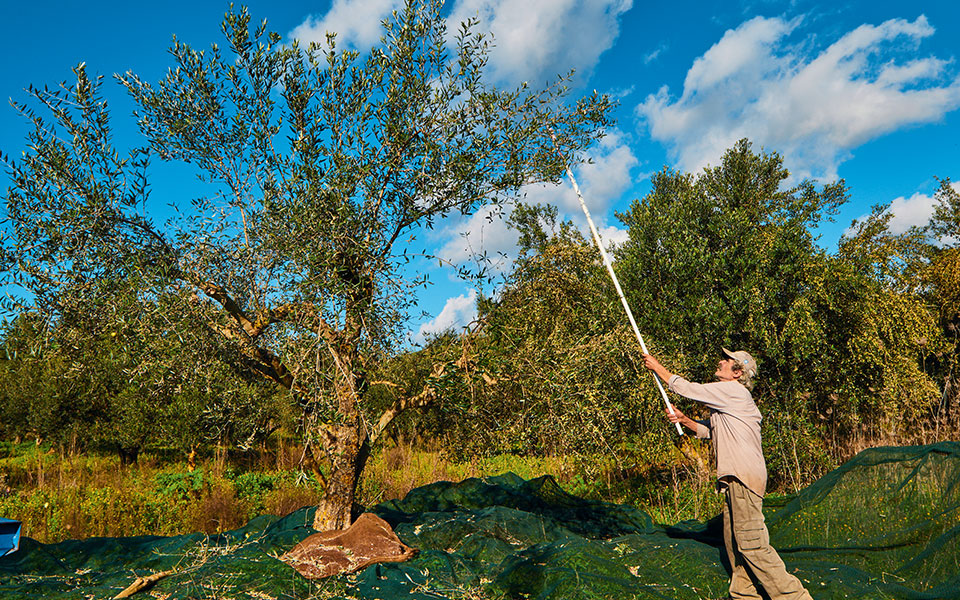
Harvest in Messinia
© George Tsafos
If one had to choose just two agricultural products to represent the Peloponnese, they would undoubtedly be olive oil and oranges. Sprawling olive and citrus groves cover the region like vast natural carpets. Such a restriction, however, would not do justice to this exceptionally fertile land, noted for its bountiful yields of myriad products.
Honey, dairy products, cured meats, table olives, fruit and vegetables, pulses and wild and farmed fish are all available in abundance. In the beautiful countryside, you’ll smell sage and thyme everywhere; from Kyparissia to Mt Taygetus to the southernmost tip of mainland Greece, Akrotenaro (or Cape Matapan). These scents mix in springtime with the fragrance of wild daffodils and the clean smell of salt from the salt pans around its bays.

Roasted kid goat - a traditional Easter dish in Mani
© Dimitris Vlaikos
Soaring mountain ranges ring fertile flatlands and forests, and there are picturesque villages, citadels, stone tower houses and, in between them all, vineyards and orchards. The local cuisine is earthy and simple – an orange, a simple pie of wild greens, a slice of bread with a little olive oil and tomato sauce.
Local olive oil is the essence of Peloponnesian cuisine. Its abundance has given rise to a broad range of fried dishes that soak up all its goodness. Kitchens here produce omelets with homemade cured meats, simple, bite-sized pies and different types of fried dough, such as lalangia (unsweetened fried “ropes” of dough, similar to churros), diples (fried sheets of dough served topped with walnuts and honey), and fluffy pancakes.

Maria Douvogianni produces "spoon sweets" and marmalade using fruit from her orchard in Messini.
© Perikles Merakos
Olive oil isn’t used just for cooking here, either; fried veal preserved in olive oil will keep for up to six months. Other traditional methods of preservation include using salt from the salt pans, in which locals cure dairy products, meat and fish.
Smoking foods is another way of preserving them, including the lean meat from home-reared pigs, which is smoked with sage to make something called pasto (“salted meat”) or syglino. Most of the older recipes that were born from the long tradition of making the most of every cut of pork have now been abandoned. The great effort required for their preparation on the one hand and the modern dietary precepts that dictate limiting heavy, fatty dishes on the other, have led to their disappearance from contemporary menus and recipe books. What hasn’t changed, however, is a love of fresh flavors.
In their cooking, Peloponnesians use a great variety of aromatic plants, especially fennel and dill, and they cook wild greens together with pulses or meat. The region is also home to many interesting casserole dishes that are finished with an egg-and-lemon sauce (avgolemono) in combination with a tomato-based sauce, a very interesting local novelty.
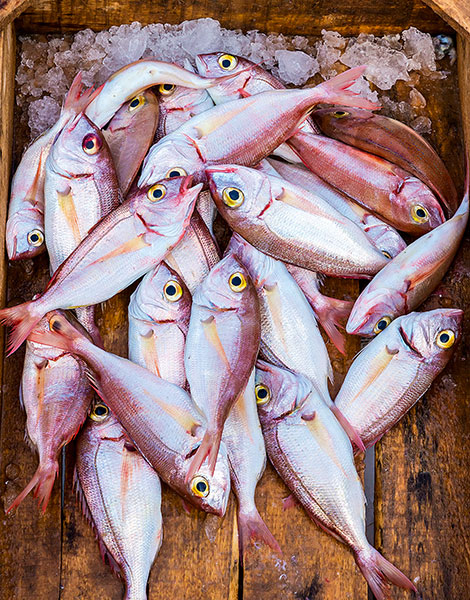
Fresh fish from Koroni
© Dionysis Kouris
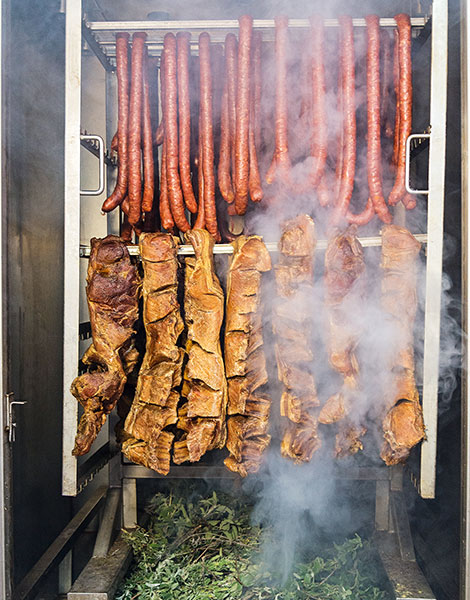
"Syglino" - Smoked pork with sage
© Perikles Merakos
This is the region with the greatest number of protected designation of origin (PDO) products in Greece. PDO olive oils from several regions in the Peloponnese are internationally renowned, as are the world-famous Kalamata olives; these products are never absent from the Peloponnesian table.
Taste the local wine – this is where the famed red Agiorgitiko is produced, as well as the crisp white Mantineia. If you find yourselves higher up in the mountains, ask for a pot of honey, ideally “vanilla pine” honey, which is thick, milky white in color, and deeply aromatic. The region is home to the black, deliciously sweet Corinthian currants as well: the Greek railway network was expanded in the early 1900s to facilitate their export to foreign markets.
The PDO eggplant of the Tsakonia region is thin, oblong and sweet, and ideal for frying. If you like pasta, try the local goges (elongated fresh pasta similar to gnocchi). The sausages and salted meat of Mani, which are redolent with the scent of citrus fruit, are particularly tasty, and you can quench your thirst in Messinia and Laconia with juicy local oranges. Sfela is the regional cheese, similar to feta, but harder. Dry myzithra is very tasty, a sharp white cheese made of sheep’s and goat’s milk, as is kefalotyri, a medium-hard salty cheese. Both are ideal for grating over pasta.
It is imperative that you take back some traditional pasteli (thin, flat honey and sesame bars) with you, as well as dried figs from Kalamata.

Rooster with "sfela" (local cheese made with sheep's and goat's milk)
© Perikles Merakos
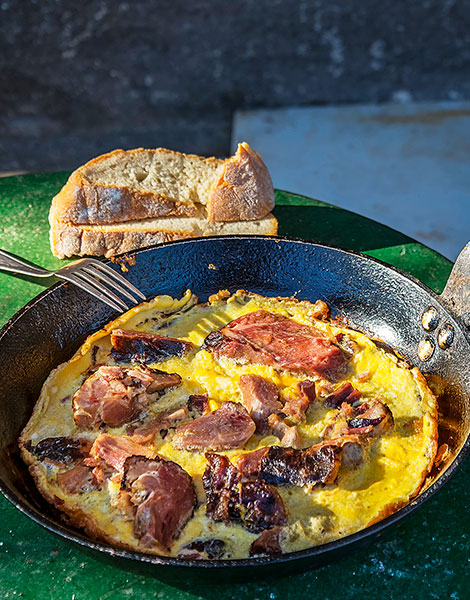
Omelet with preserved pork
© Perikles Merakos
Kagianas is an egg dish that is similar to scrambled eggs but made with grated fresh tomatoes; it has several variations, including versions with added cheese or syglino (cured meat); it is also eaten at breakfast. A special local delicacy is roast piglet, with crisp, crackly skin and mellow, tender meat.
In the local tavernas, try rooster in tomato sauce with hylopites (handmade pasta), as well as roast lamb in tomato served with egg-and-lemon sauce, a dish that requires plenty of freshly baked bread. In Corinthia, trachanosoupa, a soup made with cracked wheat, is very popular, while in Mani they prepare regali, a tomato sauce-flavored medley containing lamb offal that is served with rice.
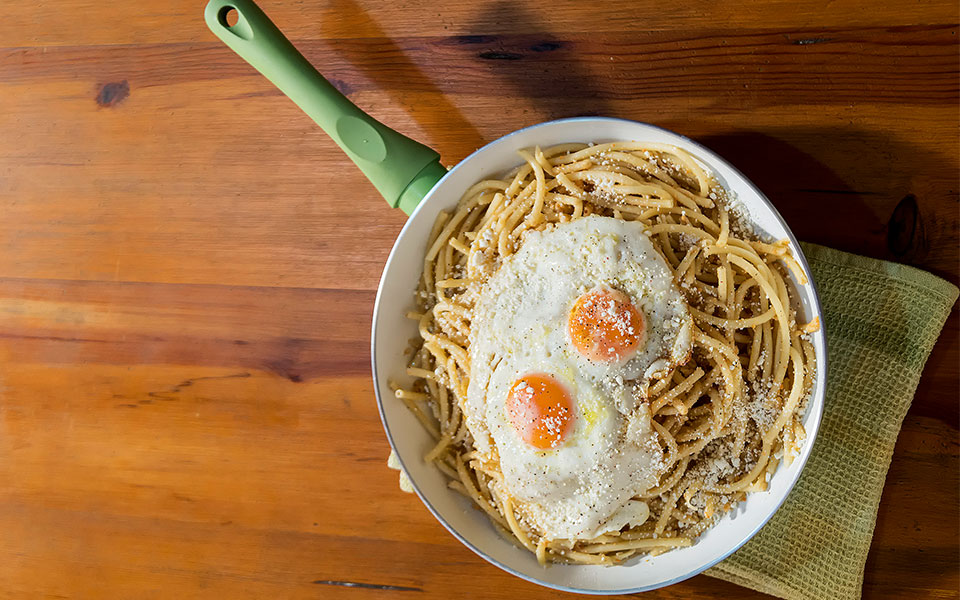
Mani-style carbonara
© Perikles Merakos
Platanos is a classic example of a traditional Greek café that serves simple and tasty regional cuisine. The traditional roast piglet, served with potatoes that are slow-cooked in the same roasting tray, is a delicacy that you really must try (84 Artemidos, Kalamata, Tel. (+30) 27210.882.66).
At Neraida, make sure you order the saitia, small local pies made with handmade pastry dough and fresh goat’s cheese and mint. The taverna also makes it own bread, with stoneground wheat flour, and its own pasta; the meat is from local sources (Aghios Nikolaos, Voies, Laconia, Tel. (+30) 27340.312.27).
The wood-fired oven at Zerzova gives the dishes an authentically rustic character. This taverna serves locally sourced meat, and game is often on the menu. Here you can taste delicious hylopites (handmade pasta) with rooster in wine, as well as wonderful savory pies (Panaghia, Arcadia, Tel. (+30) 27950.317.53, open Friday to Sunday only).
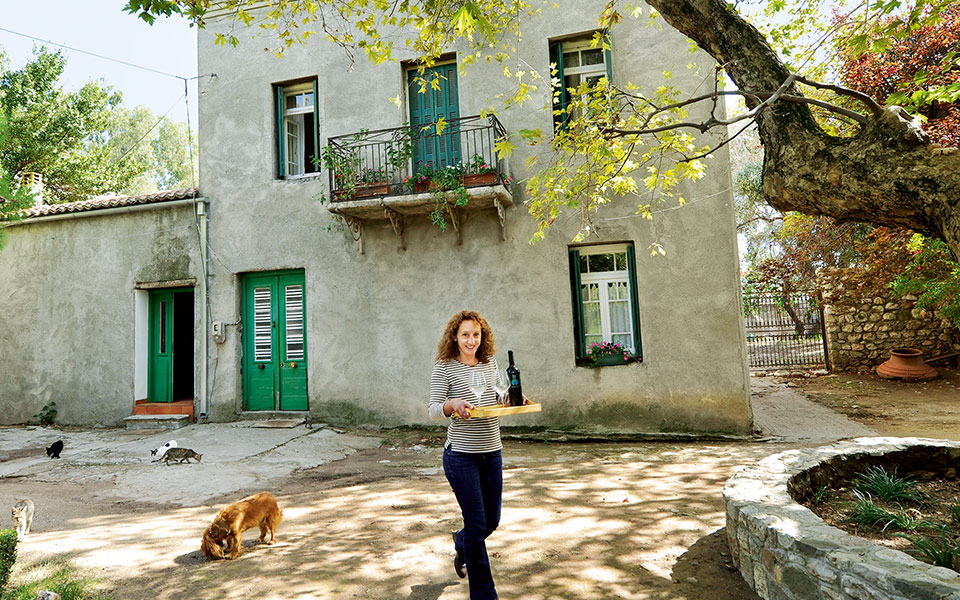
Erifili Parparoussi
© Vangelis Zavos
Fertile ground for the crafting of exciting wines, the Peloponnese is the largest grape-growing area in Greece, accounting for approximately 30 percent of the country’s vine-planted land. It features an incredible array of fascinating terroirs, numerous indigenous varieties and quality-minded producers who are raising Greek wine to new heights.
The history of vine cultivation in the Peloponnese dates to antiquity. A few kilometers from Kalavryta is an ancient vine, estimated to be 3,000 years old, which the ancient geographer Pausanias (writing in AD 160) described as “a unique phenomenon” because of its size; today, the vine measures more than 100 meters in length and consists of nine trunks.
Nowadays, the Peloponnese is home to some of the most characterful native varieties in Greece, the benchmarks being the hedonistic Agiorgitiko of Nemea and the exotic Moschofilero, with its singular perfume, from the Mantineia plateau. Other varieties, such as the mineral Roditis, the elegant, quince-scented Kydonitsa, the texturally refined Mavrodafni and the ethereal Black of Kalavryta, as well as some of the best Cabernet Sauvignon and Syrah grown in Greece, are marvelous examples of how diverse the treasures of the Peloponnese can be. Some of the area’s most vivid wines come from the high-elevation vineyards of Aigialeia (up to 1000 meters above sea level), from certain villages in Nemea (including Koutsi and Asprokampos), from the Mantineia plateau and, for international varieties, from the region of Messinia.
There are, however, many more wine destinations to explore, including Mani. Along with the area’s dry wines, the sweet wines of the Peloponnese carry well-justified reputations for their fine quality and include several expensive premium examples: Mavrodafni of Patra, the small-berried clone of Muscat and the historic Malvasia (grown in the greater area of picturesque Monemvasia) all display high levels of complexity and plenty of character.
One can say without any exaggeration that these are among the best sweet wines in the world. It seems that there has never been a better time than right now for the wine enthusiast to dive in and explore. Well-established producers such as Gaia, Christos, Mercouri, Parparoussis, Semeli, Skouras and Tselepos have been joined by a new generation of rising stars, including Bosinakis, Ieropoulos, Mitravelas, Sant’Or, Tetramythos, Troupis and many others.
Whichever route you choose, you’ll discover that the Peloponnese is a stunning destination, offering remarkable archaeological sites such as Olympia and Epidaurus, beautiful beaches on both its Aegean and Ionian coasts, fresh seafood and highly praised meat dishes, and some of the best wines in Greece.
Discover Crete’s iconic sarikopites – delicate...
Landscapes of wild beauty, legendary vendettas,...
Three traditional products serve as both...
This storied rarity, grown nearly exclusively...